Solving SEGA Genesis ROM CTF Challenge

File fot the challenge can be downloaded from here. In order to run the file we need an emulator. There are few available but I've used gens. Probably a better one could be found but at least for my purpose this was enough. After running gens and loading the jump.bin we see this:
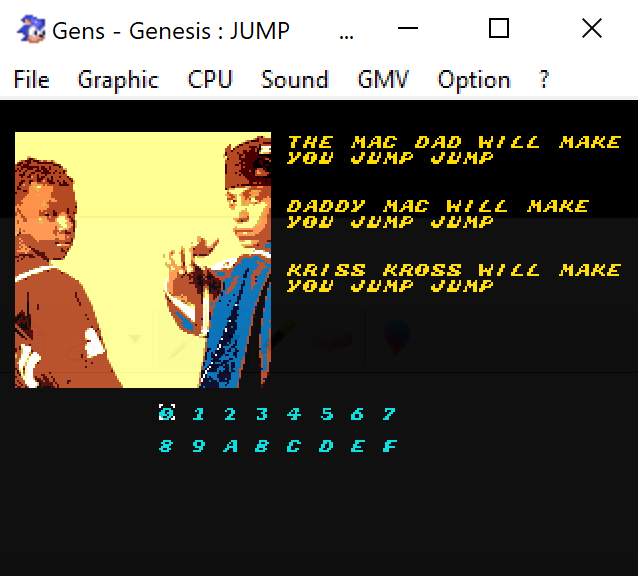
We can play with it a little bit to see what's possible (maybe some easy pass will get us somewhere) but in the end we need to do our analysis.
We will use GHIDRA here. Without some work, the ROM wont be recognized correctly by GHIDRA. We have to set the correct processor type to 68000 but ROM is not just the code.

We can skip the auto analysis as that won't give us much. We do not get much more that what would simple hex editor would give.
Luckily the tool is highly scriptable and there are scripts available to do the work for us. For this purpose just download the GHIDRA scripts from CTF author's repository here. And put them into your ghidra_scripts folder (I've used the one in $HOME directory). After doing this, open the Script editor and pick the Binary category and from that choose GenesisVectorTable.java.
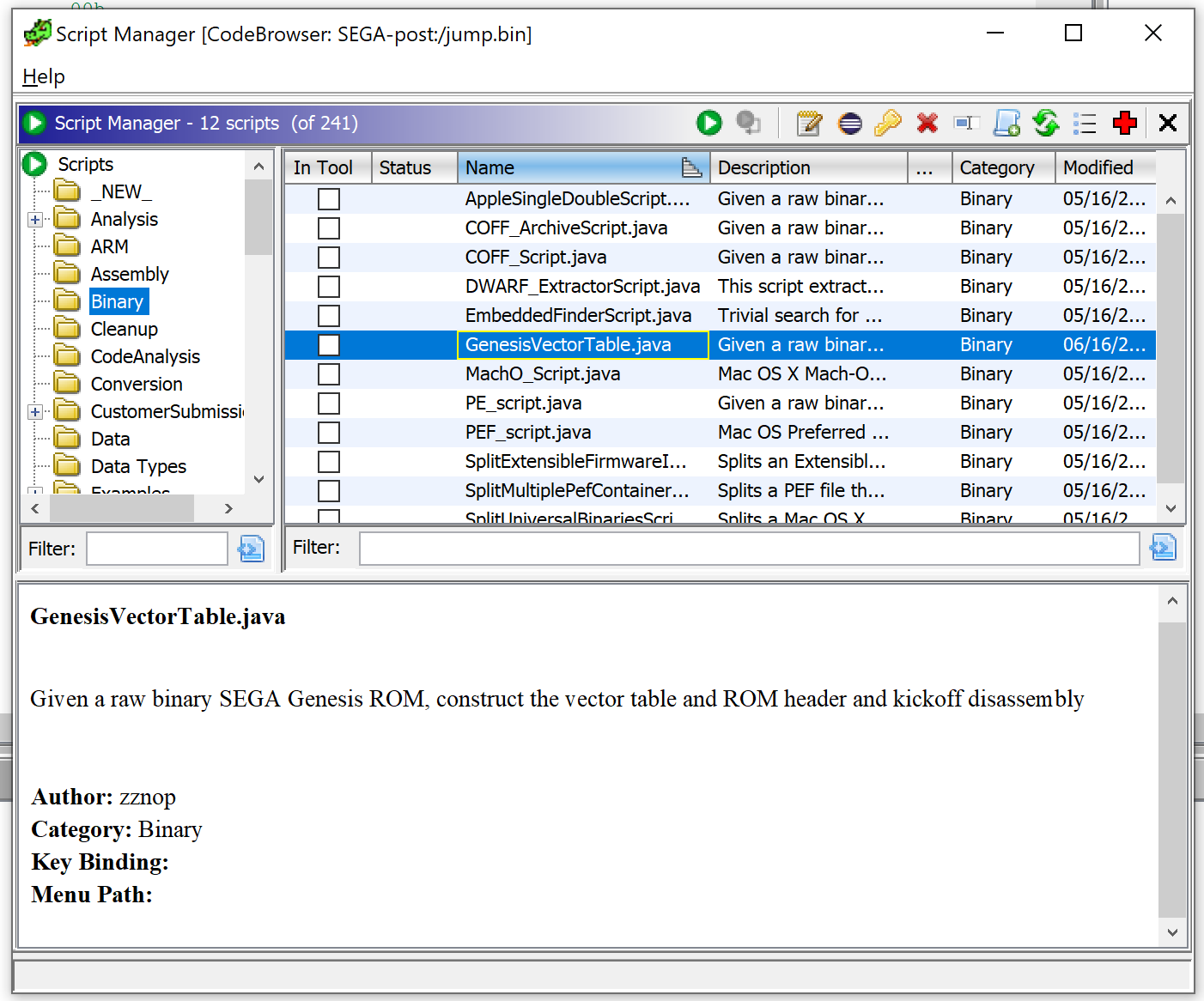
And just run it. If everything wen find (and it should) you should see some more clear information in the disassembly now.
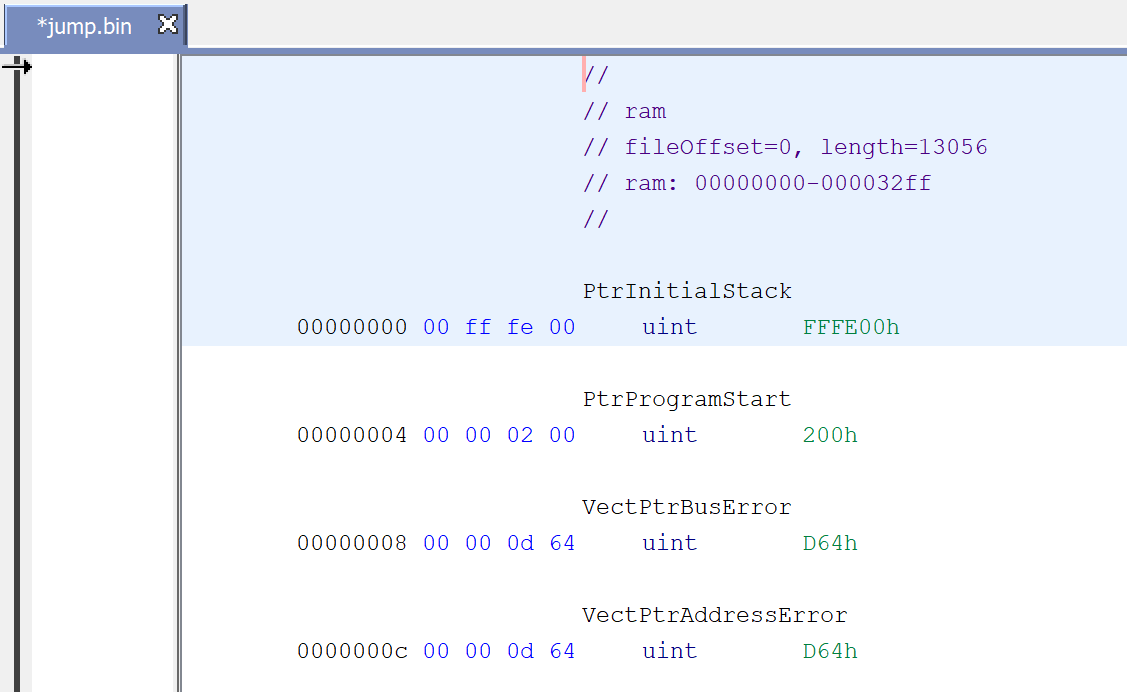
The most important thing, for now, is the PtrProgramStart which tells us where we should look for the code. Let's go there by double clicking it. If you're not familiar with 68000 assembly (I wasn't) it might be scary. GHIDRA will try to show decompiled code but with this processor type it's not so good (at least for me) but it is something. By brief look at the code we can identify something that looks to be the main loop of the challenge.

What we "just" need to do is to analyze those few functions and we should be good to go ;).
Before we jump into analyzing the function let's see what other features our emulator has. Inside CPU -> Debug menu we have Plane explorer and another submenu with processors that allows us to see CPU registers, RAM and ROM. Those will come handy in a moment.
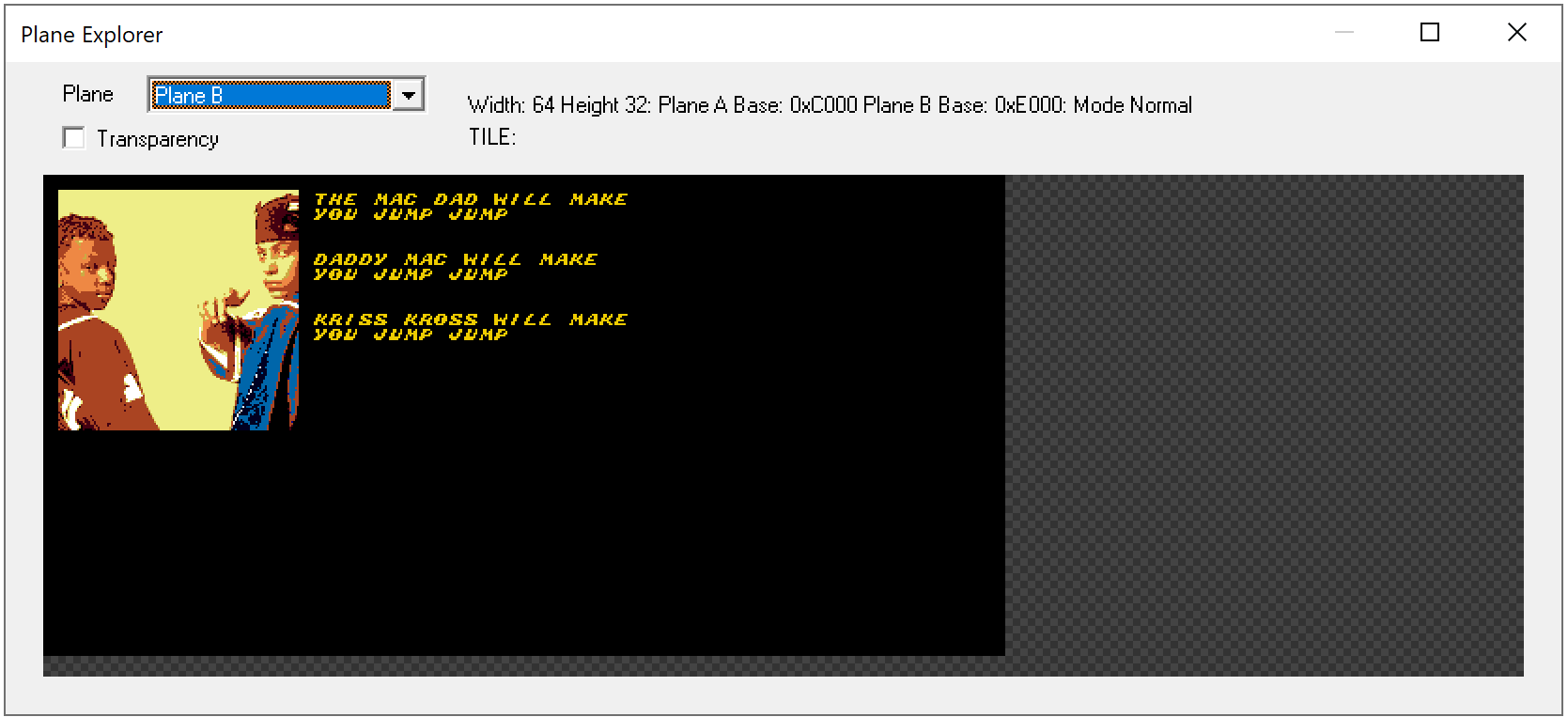
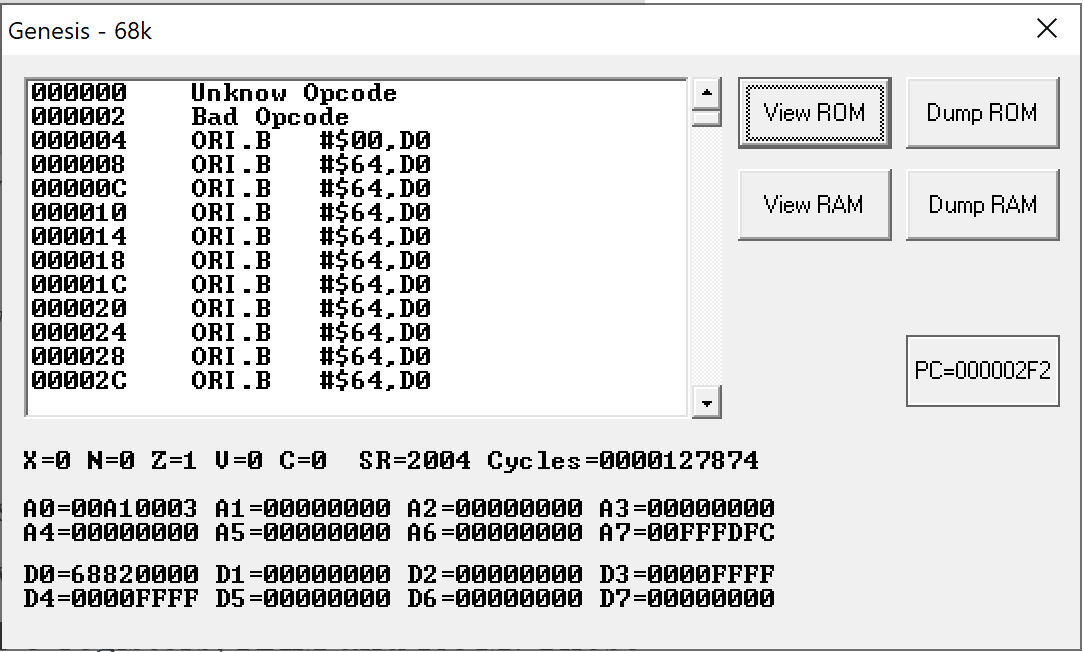
Let's use View RAM button and play with the challenge a little bit. We can quickly identify some placed that being updated when we navigate through the letters or press A.
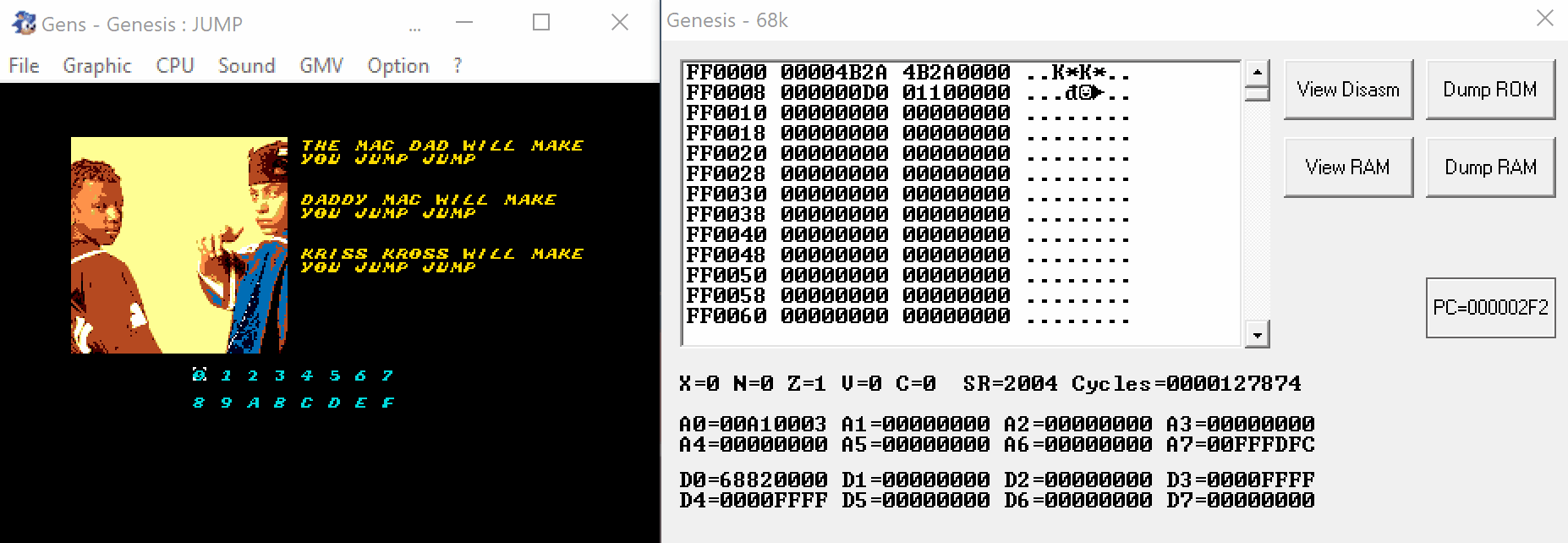
From that easy exercise (it might not be easily seen from the above gif) we can list that:
- A byte at
0xFF0006holds the input button when it's being pressed (arrows, orA) - A word at
0xFF0018holds what we entered as the flag
Having that we can jump back to our analysis.
With the above knowledge we can easily identify 0xFF0006 being used in the main loop. Our assumption is also that one of those methods needs to draw:
- the image
- the text on the right side of the image
- the num pad
- and finally our entered key/flag
I had not really much knowledge how the drawing is done, but inspecting the Plane Explorer view give some ideas that we might be dealing with some sprites that are preset and rendered using the index.

If we go the method FUN_000008da we can see something similar:
000008ea 23 fc 60 move.l #0x60a40003,(VDP_CONTROL).l
a4 00 03
00 c0 00 04
000008f4 33 fc 00 move.w #0x26,(VDP_DATA).l
26 00 c0
00 00
000008fc 33 fc 00 move.w #0x1a,(VDP_DATA).l
1a 00 c0
00 00
00000904 33 fc 00 move.w #0x17,(VDP_DATA).l
17 00 c0
00 00
0000090c 33 fc 00 move.w #0x0,(VDP_DATA).l
00 00 c0
00 00
00000914 33 fc 00 move.w #0x1f,(VDP_DATA).l
1f 00 c0
00 00
0000091c 33 fc 00 move.w #0x13,(VDP_DATA).l
13 00 c0
00 00
00000924 33 fc 00 move.w #0x15,(VDP_DATA).l
15 00 c0
00 00
0000092c 33 fc 00 move.w #0x0,(VDP_DATA).l
00 00 c0
00 00
Inspecting few first instructions gives us clear indication that this method prints the text that's located to the right of the image, so we can name it like that.
If we do the same analysis of the FUN_00000c60 we see similar pattern. This time
undefined FUN_00000c60()
0000028a(c)
00000c60 72 02 moveq #0x2,D1
00000c62 74 07 moveq #0x7,D2
00000c64 23 fc 49 move.l #0x49140003,(VDP_CONTROL).l
14 00 03
00 c0 00 04
First two lines initialize two some variables. The D2 one will later be used to execute loop body 8 times. This is exactly what we need to print one line of the num pad. The first item in this pad has id of 0x2002 and this is what we see in the following lines:
00000c6e 36 01 move.w D1w,D3w
00000c70 00 43 20 00 ori.w #0x2000,D3w
00000c74 33 c3 00 move.w D3w,(VDP_DATA).l
c0 00 00
00000c7a 33 fc 00 move.w #0x0,(VDP_DATA).l
00 00 c0
00 00
00000c82 52 41 addq.w #0x1,D1w
00000c84 51 ca ff e8 dbf D2w,LAB_00000c6e
The two lines will result in 0x2002 in D3w and later we will add 0x1 by every loop iteration.
Few lines later we have similar code that does the same for the second line. Knowing that we can rename this function to print_num_pad.
The main function is a bit clearer now, but we still have some unclear references to unravel. One would be the memory location of 0xFF0008. Inspecting RAM at that address does not reveal anything specific but by looking on how it is used it could be assumed that it's also a variable that contains an input. Seeing code that compares it with 0x40 (A) or 0x10 (S) is a strong indicator of that. We can take a guess and rename it to probably_input. Now the main loop is even more clear
if ((probably_input & 0x10) != 0) {
FUN_00000d28();
}
unaff_D7w = 0;
if ((probably_input & 0x40) != 0) {
FUN_00000414();
FUN_000003a4();
}If our assumption is right then FUN_00000d28 is a function that contains code responsible for executing code when we press S (we haven't tested that yet) and FUN_00000414 & FUN_000003a4 are responsible for handling when user press A.
Before we jump into the analysis of those function let's first check what happens when we press S in the challenge.
In most cases we end up in 0xd60c but sometimes we can end up in the same address that we've entered in the challenge.

That gives as information that we can somehow control the PC and direct it to any address in the ROM. We just need to find out where we need to be. Let's start analyzing those methods.
Let's start with FUN_00000d28. The code for this function is not long
undefined FUN_00000d28()
00000d28 30 39 00 move.w (DAT_00ff0018).l,D0w
ff 00 18
00000d2e 02 80 00 andi.l #0xffff,D0
00 ff ff
00000d34 61 00 00 02 bsr.w FUN_00000d38
We know from our initial analysis that DAT_00ff0018 holds our password. So in the next line we are limiting the entry to 2 bytes and we call another function FUN_00000d38 remembering that in D0w holds the password.
FUN_00000d38
00000d38 2e 80 move.l D0,(SP)=>local_res0
00000d3a 4e 75 rts
This function is even shorter. Remembering that D0 has our password (as a int) we can interpret this code as:
- exchange return address with the value stored in
D0 - return, so basically jump do user specified position
This explain the fact that sometimes we can end up with PC equal to user specified input. Now the real question is where should we jump?
Looking at this FUN_00000d38 we can spot some unrecognized bytes
00000d3c 33 ?? 33h 3
00000d3d fc ?? FCh
00000d3e 45 ?? 45h E
00000d3f 53 ?? 53h S
00000d40 00 ?? 00h
00000d41 ff ?? FFh
00000d42 00 ?? 00h
00000d43 20 ?? 20h
00000d44 4e ?? 4Eh N
00000d45 75 ?? 75h u
00000d46 4e 73 rte
But this rte at the end looks oddly suspicious. Maybe we should try to decode is as opcodes? In Ghidra we can do this by using D. After that we get some additional code:
00000d3c 33 fc 45 move.w #0x4553,(DAT_00ff0020).l
53 00 ff
00 20
00000d44 4e 75 rts
00000d46 4e 73 rte
Interesting. We set a value 0x4553 and store it in 0xFF0020 a new memory address.
So providing a password as 0d3c and pressing S we should get 0x4545 in RAM memory 0xFF0020. Let's see if our assumptions are correct:
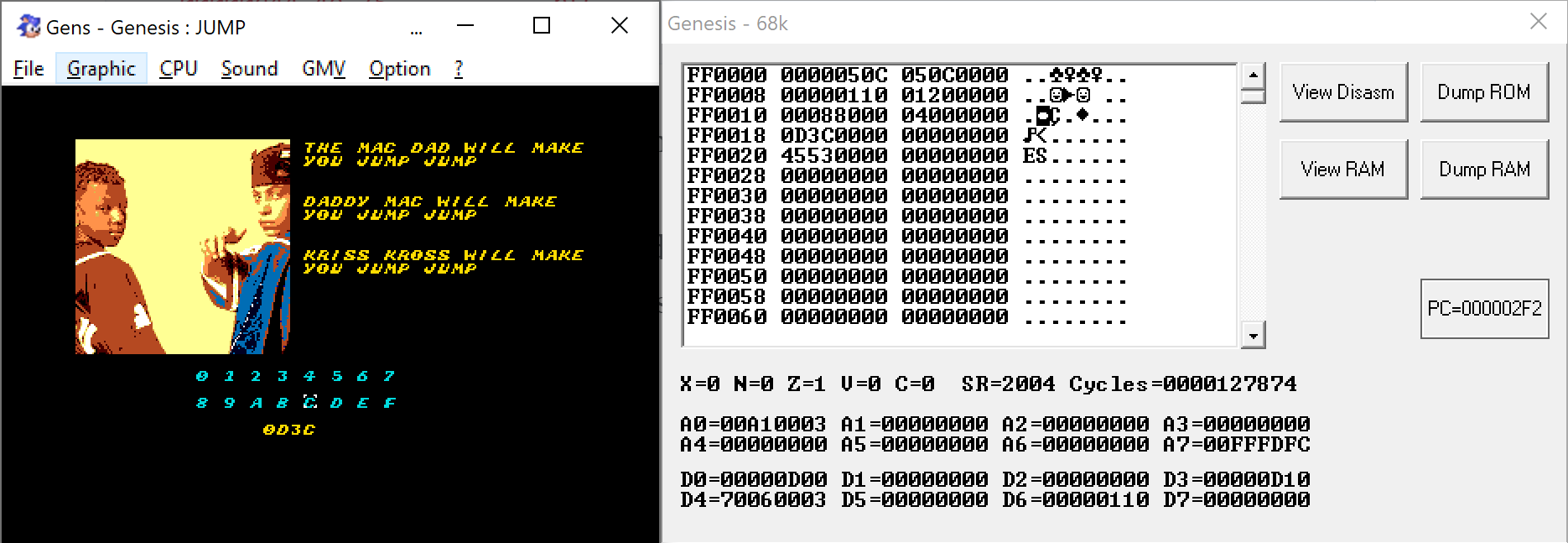
Nice! We get 0x4553 where we expect it to be! But where the flag? Since we found one part that was hidden maybe there's more? This part is not really scientific one byt by scrolling through the code we see another one. At the address 0x034c we see a similar bytes
0000034c 30 ?? 30h 0
0000034d 39 ?? 39h 9
0000034e 00 ?? 00h
0000034f ff ?? FFh
00000350 00 ?? 00h
00000351 20 ?? 20h
00000352 41 ?? 41h A
00000353 fa ?? FAh
that turns to the code after pressing D.
0000034c 30 39 00 move.w (DAT_00ff0020).l,D0w
ff 00 20
00000352 41 fa 2a 3c lea (0x2a3c,PC)=>DAT_00002d90,A0 = 5E4Eh
00000356 34 18 move.w (A0)+=>DAT_00002d90,D2w = 5E4Eh
00000358 b1 42 eor.w D0w,D2w
0000035a b3 42 eor.w D1w,D2w
0000035c 0c 42 5a 5a cmpi.w #0x5a5a,D2w
00000360 66 00 00 30 bne.w LAB_00000392
00000364 34 18 move.w (A0)+=>DAT_00002d92,D2w = 4A44h
00000366 b1 42 eor.w D0w,D2w
00000368 b3 42 eor.w D1w,D2w
0000036a 0c 42 4e 50 cmpi.w #0x4e50,D2w
0000036e 66 00 00 22 bne.w LAB_00000392
00000372 23 fc 4c move.l #0x4c060003,(VDP_CONTROL).l
06 00 03
00 c0 00 04
This is interesting. We again see that memory location of 0xFF0020 is being referenced. Also we see some XOR with 0x5E4E and 0x4A44 and with an unknown value that is passed in D1w. This one is better visible on the decompiled code here:
if (((ushort)(in_D1w ^ _DAT_00ff0020 ^ DAT_00002d90) == 0x5a5a) &&((ushort)(in_D1w ^ _DAT_00ff0020 ^ DAT_00002d92) == 0x4e50)) {
And when this condition is met we go to a function that looks like printing the flag. So we need to get this right [0xff0020] ^ 0x5E4E == 0x5a5a and [0xff0020] ^ 0x4A44 == 0x4e50 we get the flag. So let's see what the value should be:
python
hex(0x5a5a ^ 0x5e4e)
'0x414'
hex(0x4a44 ^ 0x4e50)
'0x414'
Ok. It should be 0x414 but for know we only know how to put 0x4553 in that field. We need to get some more hidden code. More scrolling technique and we locate the address of 0x2d86 with the following code:
00002d86 32 3c 41 47 move.w #0x4147,D1w
00002d8a 61 00 d5 c0 bsr.w FUN_0000034c undefined FUN_0000034c()
00002d8e 4e 75 rts
This is the exactly missing part that we needed. So in order to solve this we would need to perform the following combination:
0x0d3c -> S -> 0x2d86 -> S
Let's check that.

Voilà!
